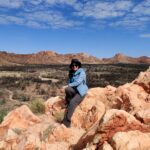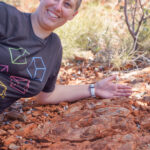Clare Fletcher
Clare Fletcher (they/she) is a PhD candidate at the University of New South Wales’s Australian Centre for Astrobiology in Sydney, Australia. Their PhD focuses on exogeoconservation of Mars – understanding important geological sites and features, particularly potential evidence of life and palaeoenvironments, and how we can best protect them while allowing continued exploration of Mars. Clare has previously completed an MPhil which focused on creating a roadmap for the geoconservation of the oldest evidence of life on Earth – 3.5 Gya stromatolite fossils in the Pilbara region of Western Australia, which have been studied by space agencies in preparation for Mars missions such as Mars2020 Perseverance.
In Crew 292 Mangalyaatra Clare will undertake the role of Crew Journalist, utilising their experience as a science writer to convey the experiences of the crew and articulate the research they undertake. Clare is additionally undertaking research for their PhD while at the Mars Desert Research Station and is participating in both Crew 291 Expedition Boomerang 3 and Crew 292 Mangalyaatra. Over four weeks at the MDRS, Clare’s research for their PhD will seek to understand how humans impact the Mars environment over varying temporal and spatial scales. The key outcome of Clare’s time at the MDRS will be to create a method to determine in situ what astrobiological features need to be protected and how to best do that. The purpose of this study is to come up with a way for astronauts and mission teams to effectively consider exogeoconservation as they explore and sample, without necessitating extensive reconnaissance for every location or outcrop. No such studies have been conducted before, and there is currently no best practice for scientific sampling that takes into account the protection of vitally important study features on Mars while still allowing sampling.
Clare is a member of the Mars Society of Australia, the Australian Centre for Astrobiology, and the IAA Moon Farside Protection Permanent Committee. They have worked as a writer for SpaceAustralia.com and helped run social media accounts for the Australian Centre for Astrobiology. Clare has presented their work at the UN COPUOS Legal Subcommittee Meeting in 2023 and at various conferences across Australia. Clare also teaches courses in astrobiology and science communication at the University of New South Wales.
Annalea Beattie
Dr. Annalea Beattie is an artist who uses art as a methodology for thinking about how we might live together in the future on Mars. Her art practice is set on space science expeditions to extreme environments on Earth, those that have conditions analogous to other celestial bodies. This is her third trip to Utah. In her last rotation to the Mars Desert Research Station, Annalea was a crew member of the three-month space simulation and science mission Mars 160. On this rotation she will lead Crew 292.
Apart from this busy role, Annalea’s own art-based research will focus on environmental stewardship, exploring a politics of care through dialogue, reflection and making art. Through co-creation, art making will address the nuances and complexities of what constitutes a frontier environment, looking closely at concepts of ‘wilderness’ and ‘free’ space. With the aim of broadening our understanding of how we imprint onto worlds that are not our own, her project thinks through materials and making to develop an ethics of reciprocal responsibility, one that can be translated to elsewhere⎯to Ladakh⎯and when we travel off-Earth to Mars. This project will emphasise our collective responsibility to both the human and the nonhuman and the potential of art as a catalyst for change.
Annalea Beattie is a Director of Mars Society Australia and of the National Space Society of Australia. She has contributed to four Springer volumes on extra-terrestrial liberty, speculating through her art practice how art making can sustain and invigorate communities off-Earth. Annalea is Adjunct Professor at the Centre of Excellence in Astrobiology, Amity University, Mumbai. She is a member of the International Dark Sky Association and The Association of Mars Explorers.
Aditya Krishna Karigiri Madhusudhan
Aditya is currently pursuing his Master’s degree at McGill University in Canada, specializing in observational cosmology. His research focuses on studying dark energy via 21-cm intensity mapping using large radio interferometers. Prior to this, Aditya earned his B. Tech in Mechatronics engineering, cultivating expertise in robotics, machine learning, and electronics. He later followed his passion to explore the world of astrophysics by undertaking the visiting student position at Raman Research Institute, India. Aditya delved into the realm of radio astronomy, laying the foundation for his current exploration of the early universe at McGill.
As the crew executive officer and crew astronomer, Aditya is determined to foster a collaborative and efficient team environment. In his role as the Executive Officer, he is focused on ensuring smooth communication and coordination among crew members, optimizing workflow, and addressing any operational challenges that may arise during missions. As the designated crew astronomer, his central objective is to formulate comprehensive plans and effective strategies for the construction of an observatory in preparation for the upcoming analog station in India. In addition to this, his secondary objective is to make use of the MDRS Musk observatory to capture and analyse potential solar events which in turn will provide a deeper understanding of solar phenomena and its implications for space travel and exploration.
Using his expertise in radio astronomy, Aditya aims to set up a simple radio telescope to detect radio emissions from space objects. Radio waves can penetrate through various obstacles, such as dust clouds and gas, that can block visible light. They can be operated 24 hours a day and are not affected by weather conditions. Having a radio telescope complements the existing optical telescopes and can provide a deeper understanding of celestial objects across various regions of the electromagnetic spectrum.
Bharti Sharma
Bharti Sharma, an exceptional geologist and visionary behind AADYA – PLANETARY AND GEOSCIENCE RESEARCH, stands as a shining example of unwavering dedication to pushing the boundaries of geology. With a Bachelor’s in Earth Science from Amity University Haryana and Master’s in Geology from Doon University, Bharti has woven together a colorful tapestry of experiences in the GIS and Geoscience industries, research, and impactful roles as a Field Teaching Assistant. Her brainchild, AADYA, serves as a stronghold for Geotourism, Skill Development, Collaborative Research, and Geo-Consultancy, showcasing her immense passion as a geologist and a Geo-Space Entrepreneur, a term which has coined for herself.
Bharti’s passion for planetary geology grew significantly during her time as a Research and Field Teaching Assistant in Ladakh. This experience served as the starting point for her exploration of the mysteries surrounding celestial bodies. With a specialization in planetary analogue research, she skillfully identifies similarities between various celestial entities and Earth, delving into the complexities of their beginnings and development. Her unwavering dedication to the field of planetary geology establishes her as a pioneering figure, continuously advancing humanity’s knowledge of cosmic phenomena.
As the Science lead of MDRS CREW 292, her mission is to study the geological and geomorphological features of Utah, intricately linking them with the terrain of Leh and Mars. Equipped with field analysis and remote sensing techniques, her primary goal remains the comprehensive understanding of various terrestrial analogue sites, thus bridging the gap between Mars and Earth Geology.
As an enthusiastic member of Women in Space South Asia, Bharti actively promotes increased female participation in space science, fostering opportunities for aspiring space enthusiasts. Apart from her illustrious career in geology, Bharti finds solace and motivation in exploring various landscapes around the world, satisfying her innate curiosity about the diverse aspects of our planet.
Daniel Loy
Daniel Loy is a first year Astrobiology PhD student from the Open University (UK) who will be fulfilling the roles of Crew Biologist and Health and Safety Officer for Crew 292. In his PhD project he is investigating and characterising the microbial communities and their interactions with the host sediments of the Makgadikgadi Basin in Botswana. The Makgadikgadi contains several salt flats with conditions that are very similar to ancient Mars, so this research will also be used as an analogue for the Noachian-Hesperian transition in Mars’ early history.
As the Crew Biologist, Daniel’s project will focus on recovering and extracting DNA from halophiles and other extremophiles to investigate the functional and taxonomic diversity of salt deposits and other gathered samples. Daniel will build on the established foundation of the research conducted in previous analog missions at the MDRS through the application of cultivation-dependant techniques that he developed during his Masters research project on recovery of entombed halophiles from salt crystals to isolate cultures of halophile; growth experiments will then be used to identify the metabolic potential of these isolates.
Daniel will also develop, modify and employ field-appropriate cultivation-independent techniques; this will involve use of the Bento Lab, a portable centrifuge, gel station and PCR machine, in combination with Hot Start PCR polymerases, PCR primers for an array of biogeochemical cycling genes and the MoBio DNA extraction kit, which will be modified for application with reduced facilities. With this combination of equipment, Daniel will perform DNA extractions in the hab-unit with both his isolates and Utah Desert Samples collected under mission-simulated conditions. These DNA samples will then be screened for functional genes via PCR.
This combination of techniques will provide baseline of fundamental cultivation dependant (isolations) and cultivation independent techniques (DNA extraction and PCR) that are achievable under analog mission parameters. This will then form the methodological framework for training framework and protocols that could then be carried out by non-biologists for future crews, at the MDRS, the Ladakh research station site or other locations. These techniques also represent more low-cost and sustainable techniques that can be carried out long-term and do not depend on reagents with a short shelf life.
Daniel Loy is a Junior Officer with the Royal Naval Reserves in the UK alongside his current studentship. He has previously investigated halophiles during his Masters research project with a focus on entombing microorganisms in salt to study how rapidly they recover and grow once outside of the crystals.
Mehnaz Jabeen
Mehanz Jabeen trained as a Geoinformatics professional at The Energy and Resource Institute (TERI ) School of Advance Studies Leh. She is a member of the Ladakh Science Foundation. Her Geoinformatics is an interdisciplinary branch of science which deals with cartographic geovisualisation, GIS, Remote Sensing, Photogrammetry, spatial statistics, multivariate statistics and other advanced tools and techniques. She is able to contribute in all kinds of spatial analysis using different geospatial techniques, artificial intelligence & machine learning, generate maps and provide valuable contextual information to science and planning teams. Mehnaz is experienced in applying geospatial technologies to solve real world challenges in environmental, social and economic domains by acquisition of data, exploring, visualizing and analyzing various spatial data. In Utah she will primarily focus on the green hab. Her own interest is how we might combine traditional nomadic knowledge to establish a green house in Ladakh where natural vegetation grows and survives in winters when temperatures drop to minus 20 degrees.
Rajvi Patel
Mangalyaatra Crew Engineer Rajvi is an aerospace engineer at Kaleidoscope Innovation where she works on commercial aircrafts to make them safe to fly. She pursued her master’s in aerospace engineering from the University of Michigan Ann Arbor with a specialization in Space Systems working on satellites and space mission design. Prior to this, she worked at Raytheon Technologies in Bengaluru, India. During her journey in India, Vikram Sarabhai Community Science Centre (VASCSC) was her second home where she explored the world of science beyond the rigid framework of theoretical classes. Throughout her life, she has explored her passion for engineering by working with unmanned aerial vehicles (UAVs), aircrafts, robots, satellites, and spacecrafts. She loves to build things and make it work. She aspires to be a space explorer which drives her motivation for being on Crew 292.
Additionally, Rajvi has led multiple community initiatives like educating underprivileged kids and awareness activities for women empowerment. She co-led an international organization called Graduate Rackham International (GRIN) at the University of Michigan Ann Arbor. She also loves hiking, traveling, reading, doing yoga and swimming.
As a Crew Engineer on team Mangalyaatra, she will utilize her engineering expertise to routinely monitor the equipment used by the crew and repair them in case of systems failure. Her duty will include providing daily status reports for each piece of equipment. In addition to these responsibilities, she will conduct her research that primarily focuses on propellant production utilizing water-bearing minerals at the Mars Desert Research Station (MDRS), Utah. Utilizing such propellants could decrease the cost of interplanetary travel and prove to be an additional source of propellant for the space exploration crew.










You must be logged in to post a comment.